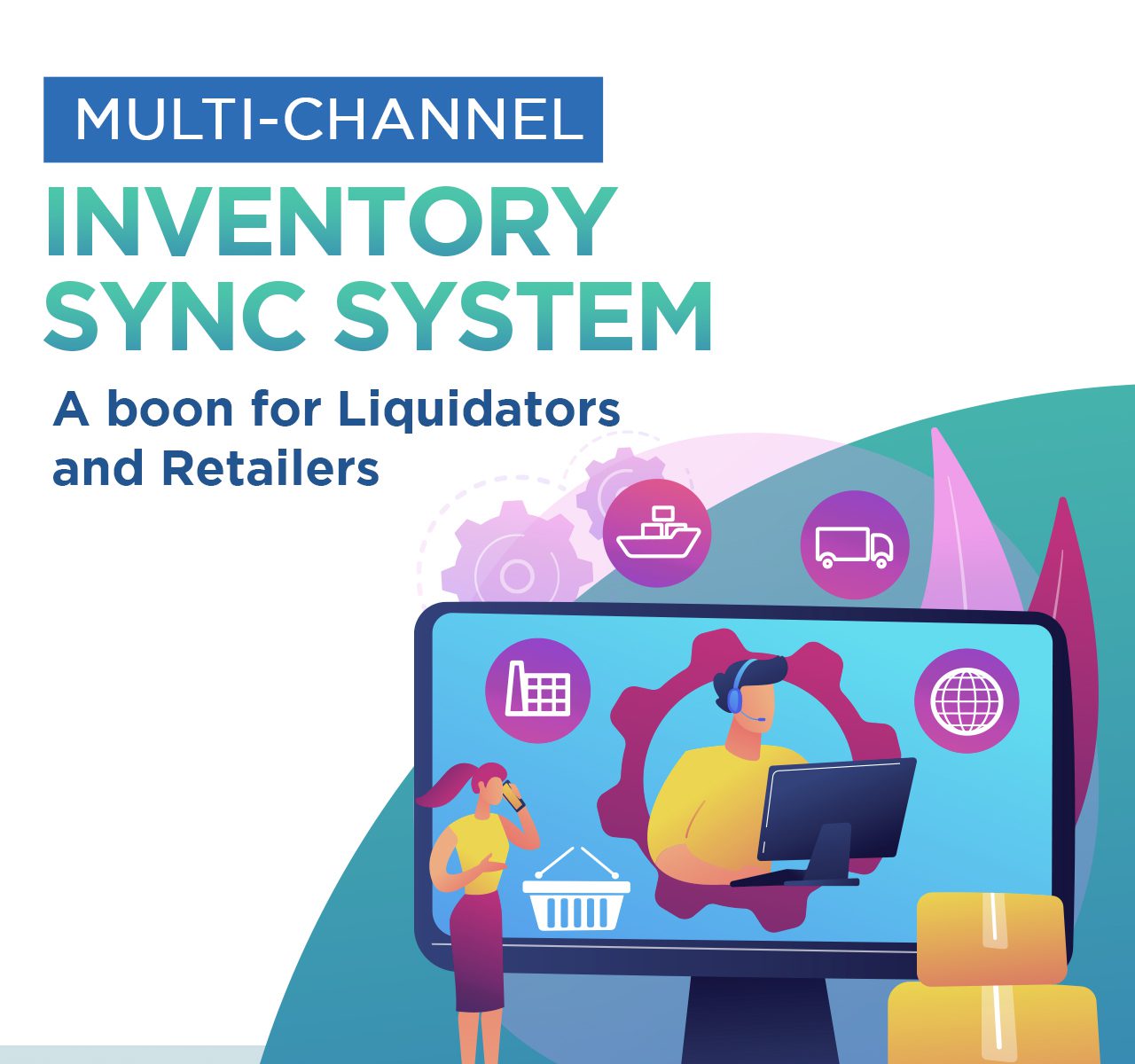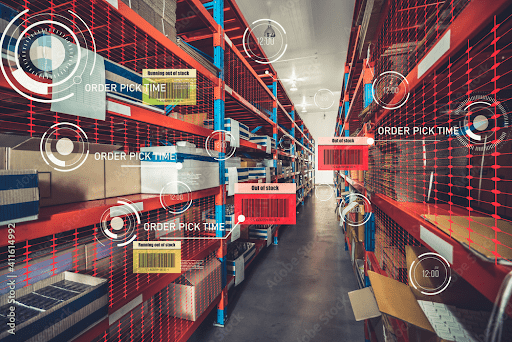
Multi Channel Inventory Sync System – A Boon for Liquidators and Retailers
If you are a small online business owner, you know how exhaustive it can be to manage inventory across multiple storefronts in real-time. This is particularly true during holiday seasons when sales volume ramps up. Asynchronous communication of inventory updating protocols is a major challenge that you should aspire to overcome. With a multi channel inventory sync system, that’s now possible!
What is Multi-Channel Inventory Management and Why is it Important?

How often have you found yourself tracking your inventory manually on spreadsheets because you have various sales channels? Or maintaining multiple inventory systems to keep track of your stock?
The process of keeping track of inventory stored in different locations and used for multiple sales sources. Sometimes the same inventory you have stocked for retail business is also used in the e-commerce sales platform. You will need to constantly track your stock levels, place reorders, and estimate inventory forecasting in real-time.
Manually tackling these issues can be incredibly time-consuming and unnecessary. Multi-management inventory on its own is a basic solution for your growing business that can help you make well-informed decisions.
What Are Some Common Issues in Managing Inventory across Multiple Channels?
On average, multi-channel retailers are only 63% accurate in their inventory records. This can lead to a lot of issues when it comes to order fulfillment. This, in turn, reduces your profitability, customer experience, overhead, and shrinkage. Hence, when you run your business on different channels, you can be exposed to new risks.
1. Overstocking
By overestimating demand across various channels, businesses end up overstocking their inventory. Unmoved inventory will end up costing you in storage fees and increased insurance rates. It also restricts your future investments as your storage space is unnecessarily occupied. Even worse, your cash flow slows down from the dead stock. In such circumstances, you will find yourself liquidating the excess stock.
While selling on different channels, the likelihood of accepting orders for the same stock is significant. With a manually managed inventory system, you might accept payment for an item that is no longer in stock. This can ruin a customer’s experience with your business and make them unhappy. Your business’s reputation is damaged while also losing a paying customer.
3. Delivery
Shipping is a lot easier to follow through when you only have one channel for orders to flow through. When you start adding more channels, shipping can get quite complicated as you have orders coming in from multiple points. Orders might get shipped to the wrong customer due to the lack of clarity in processing.
20% of online sales see product returns. Product returns management is another key aspect of inventory management. Product returns by customers add to your inventory and can be sold again. Being able to track and record returns can help ensure that your business does not have any unsold stock.
How can a Multi-Channel Inventory Sync System Aid in Inventory Management?
A multi-channel inventory sync system is simply a centralized inventory system. If you have a business that has multiple sales channels, you can simply use a multi-channel inventory system to keep accurate, real-time records of your stock. The implementation of such a system can help you avoid losses due to mismanagement of inventory.
A multi-channel inventory sync system is the all-in-one solution for your ever-expanding business. Stay in control of your business inventory across all channels on a single platform. Choosing the right multi-channel inventory system for your business can help you efficiently boost your recordkeeping. You can even track shipping, orders, and suppliers to provide valuable insight for inventory management decisions.
What are the Benefits of Using a Multi-Channel Inventory Sync System?

1. Data Integration
Without the ability to track customers’ purchases, many marketing opportunities go amiss and are often misdirected. The organization must be committed to understanding the purchase patterns to make important decisions on which marketing strategy to use. Therefore, data integration is more useful as it allows retailers and liquidators to analyze the true triggers for purchase.
It helps in analyzing which efforts are most profitable, and also to make an intelligent allocation of marketing dollars across channels. It can aid in avoiding issues in data management, assist in liquidating old and surplus inventory, help in identifying valuable customers in multi-channel retailing, data integration. Data integration solves the question concerning the decision making between investing more in search engine optimization or catalog designing.
2. Automated Inventory Tracking
As a merchant, you need to avoid having any low-in-demand inventory that increases your spending on warehousing thus decreasing your revenue. An automated system allows retailers to manage inventory in real-time, and make business-critical decisions in a timely fashion.
Sellers can better organize products in categories and avoid overselling. Inventory management displays which products sell well during specific periods and which are better suited for other times or even sales channels. This makes it easier to synchronize data across all sales channels. With the help of inventory data, it is easy to make data-driven decisions regarding your stock and promotion activities.
3. Real-Time Product Control
Syncing a retailer’s inventory across all channels in real-time will help in retrieving the precise information necessary for making informed and quick business decisions. It allows you to visualize the big picture of what is happening with the inventory and help your business act accordingly to the supply-chain demands.
Real-time product control in a multi-channel inventory will help you gather and provide up-to-the-minute information about your inventory system as and when required. This will enhance customer experience, aid in avoiding stock-outs, meet delivery schedules more easily, and optimize workflow.
What are the Features You Should Look For in a Multi-Channel Inventory Sync System?
1. Multi-Channel Synchronization and View

A good multi-channel inventory sync system should enable you to gather information across all the channels you use for selling your product. All your sales, fulfillment data, supply chain automation workflow, and other such information should be manageable in one system. The availability of such data in a single resource will enable you to compile data from different channels to get an overall view of product performance, and profitability, comprehensively and per-channel.
Multi-channel synchronization and view will greatly contribute to performing multiple tasks such as updating product information for each channel, viewing sales, stock information, logging returns, etc. All channels can be connected and updated simultaneously. This will result in offering your customers a seamless user experience.
2. Inventory Control and Sales Forecasting

Inventory control and forecasting are the most important parameters of quality inventory management. Products, core components, product variations, bundles, and kits need to be tracked and managed to ensure seamless sales of goods.
This is where Stock Keeping Unit (SKU) flexibility can aid in access to product data and tracking inventory across different channels. SKU flexibility will enable you to replenish your inventory as and when needed. You can also monitor which products are selling best on which channel and redirect investment towards the same.
The inventory sync system you utilize should ideally track and store sales data which you can subsequently use to forecast sales patterns and plan your inventory. Sales forecasting along with inventory planning will help in capturing periodic gains.
3. Effective Reporting and Data Analytics

Creating reports and analyzing data is crucial to the optimization of sales. Inventory analytics plays a large role in the effectiveness of inventory sync systems. The analytics collected should be actionable, insightful, and measurable. Sales by product, channel, inventory valuation, cost of goods sold, return summary, etc. are a few reports to look out for. Using data analytics to make business decisions will reduce costs and maximize your profit margins.
4. Integration with Third-Party Platforms and Other Softwares
Any business incorporating the multi-channel inventory system will want their customers to have a great user-friendly experience. By integrating with third-party platforms, your business can achieve this. It will also benefit you by ensuring that your product information is retained the same across all platforms. Moreover, it helps in centralizing the sales, which will help you in making sales analysis easier.
5. Barcoding and Scanning

An important aspect of your multi-channel inventory sync system is barcoding and scanning. This refers to the managing and maintaining of information collected from real-time data across all your inventory locations. Accurate stock data can be obtained as you can keep track of the directory as and when it gets updated.
6. Ease of Customization
Configuration and customization are vital features that you need to be looking out for. Different businesses operate differently. Customization is the key to the easy implementation of inventory management strategies. You need to find software that offers the freedom to configure your requirements and customize the system to effectively manage your inventory.
7. Warehouse Management

Inventory management processes of companies with large warehouses undergo regular deliveries, time-consuming manual data entry systems. This leaves more room for errors. Inventory management systems that integrate the usage of smart devices enable up-to-date electronic records. Deliveries can be time and date-stamped for effective tracking. Product traceability can be improved with batch tracking.
Conclusion
A multi-channel inventory sync system is essential for any business that wants to focus on improving customer service and reducing inventory space at the same time. Increasing efficiency and profitability are the core factors that need to be monitored while enhancing your current system.
By keeping track of real-time industry practices and combining information from all the sales channels, you can develop an optimized and sophisticated inventory management system.
To conclude, multi-channel inventory management and synchronization is the most vital sync system you need in place to keep track of and avoid overselling your stock and inventory, control your overall product performance and maximize sales and revenue.








